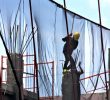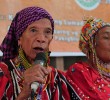
By Carlos H. Conde
davaotoday.com
DAVAO CITY — This seems like a no-brainer but it�s worth mentioning: When you travel cross-country make sure to bring an ice-filled cooler, even the ordinary Styrofoam ice chest fish vendors use. You�ll regret not bringing one, trust me.
It�s not because you can�t find ice-cold soft drinks or bottled water along the way. You can easily get these from convenience stores or eateries in cities and towns that you pass by.
The thing, however, is that, many of the nicest spots that you can enjoy while traveling by land from Mindanao to Luzon are in areas where there are usually no convenience stores or filling stations.
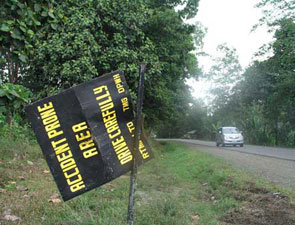 For example, in a recent trip from Davao to Manila, I and my partner Daisy stopped by a ricefield near Kitcharao town in Surigao. We took pictures of farmers harvesting rice. We chatted with them for a few minutes. And we enjoyed ice-cold Coke under the shade of a mango tree, the cool breeze massaging away the pain in my back caused by hours of straight driving. Splendid.
For example, in a recent trip from Davao to Manila, I and my partner Daisy stopped by a ricefield near Kitcharao town in Surigao. We took pictures of farmers harvesting rice. We chatted with them for a few minutes. And we enjoyed ice-cold Coke under the shade of a mango tree, the cool breeze massaging away the pain in my back caused by hours of straight driving. Splendid.
Bringing an ice chest, of course, is just one of the many small things you can do to make traveling across the country enjoyable and convenient.
Daisy and I made sure to bring two pillows, an umbrella, a flashlight, a camera, extra batteries, enough reading materials, candies, lots of bottled water, and Skyflakes.
Being the driver, I had to make sure that our car was in tip-top shape, that we had a spare tire and the usual tools. Perhaps the single most important thing you should never forget to bring is a copy of your car registration, which is needed for the ferry (or Roro) trips between Surigao and Leyte and Samar and Sorsogon.
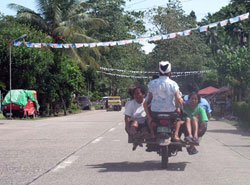 Also, fill up your gas tank as often as you can, even if it�s still half-empty. Unless you are familiar with the route, you�ll never know when the next gas station will be. This is particularly important for those who use unleaded gas, which is not sold in many filling stations along the way.
Also, fill up your gas tank as often as you can, even if it�s still half-empty. Unless you are familiar with the route, you�ll never know when the next gas station will be. This is particularly important for those who use unleaded gas, which is not sold in many filling stations along the way.
Before embarking on this trip, Daisy and I made sure that we had no work and other commitments the week ahead. We planned the journey more as a sightseeing tour than just a mere trip. Because we were not in any sort of hurry, we had the luxury of stopping whenever and wherever we wanted.
Daisy was particularly thrilled by this setup, given that it was her first time to explore the country this way. I, on the other hand, had been on this trip four times before, and each trip was a thrill � tiring, yes, but a thrill just the same.
Although there are Philtranco buses that ply the Manila-Davao route, I have to say that it�s not the same as driving your own car. The most obvious reason is that, on a bus, you are at the mercy of the driver, which limits your opportunities to really enjoy the journey.
On a Philtranco bus, the trip usually takes two days of straight driving. In our case, because we decided not to drive during the night as much as possible, the trip took us four days.
From Davao, we took the Buda highway via Bukidnon to Cagayan de Oro. This leg of the trip was hassle-free because the road was in excellent condition. Suggested stops are the carabao center by the foot of Musuan Peak just before Valencia City, and the fruit stands in Maluko, near Manolo Fortich, where we bought fresh pineapples and macopa.
We spent the night in Butuan City and left for Surigao City at 8 a.m. the next day. From there, we took a Roro ferry to Liloan, Southern Leyte.
I didn�t get the chance to check the rates for other types of vehicles but I paid 2,185 pesos for the Toyota Altis, 50 pesos for barangay tax, 112 pesos for Roro terminal fee, 16 pesos for another terminal fee, and another 50 pesos as �entry free.� Passenger fee for the driver was waived; Daisy had to pay around 150 pesos as ferry fare.
The journey between Liloan, Southern Leyte, to Tacloban City was uneventful, but since we were traveling a week after typhoon �Caloy� battered Eastern Visayas and the Bicol region, portions of the road in Southern Leyte, particularly near Sogod town, were still blocked by landslides, which are common in these parts.
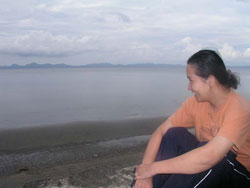 We spent the night in Tacloban, at a �budget hotel� (700 pesos a night) by the national highway that was actually far better than the 2,000-a-night hotel we had stayed in in Butuan.
We spent the night in Tacloban, at a �budget hotel� (700 pesos a night) by the national highway that was actually far better than the 2,000-a-night hotel we had stayed in in Butuan.
We had wanted to stop by the famed San Juanico Bridge the next morning but a huge sign said passengers could not stop near the bridge, let alone on the bridge. So we cruised at less than 30 kph, enjoying the view of the strait between Samar and Leyte, the small islands, and the sheer majesty of the bridge.
Up until this point, the trip had been enjoyable for the most part. As soon as we reached the first town of Samar, however, despair set in. The first sign was the concrete road. To call it potholed is an understatement. What we saw, what I had to negotiate almost every 20 meters, were craters, not potholes. Some sections of the highway had completely collapsed.
The road was like that practically up to Allen, the port town where we would take another ferry to Matnog, Sorsogon. I wondered how the bad road affected the lives of the people in Samar. I was certain they had to pay more for buses, jeepneys and �skylab� motorcycles. Plus, in this part of the world, the highway is the center of their universe: children turn it into their playground and farmers use it to dry crops.
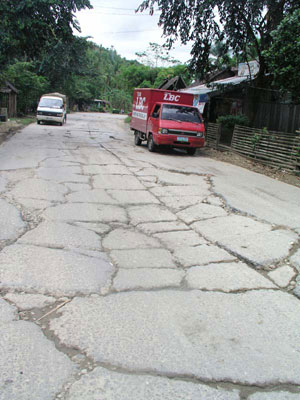 I was actually tempted to stop at one point and ask the residents how the horrendous road had affected their lives. I have since regretted not doing it.
I was actually tempted to stop at one point and ask the residents how the horrendous road had affected their lives. I have since regretted not doing it.
The port in Allen was extremely crowded. Dozens of buses were parked every which way. We waited for hours before we could leave the port on a Roro ferry. (This time, I only paid 800 pesos for the Altis, 9 pesos for arrastre fee, 107 pesos for terminal fee, 36 pesos for �wharfage fee,� and about 100 for Daisy�s fare.)
(A word about these Roros: they�re not exactly the most convenient. They�re dirty, with roaches crawling all over the place and restrooms that are, to put it mildly, unclean. But they�re bearable because the trips last no longer than three hours.)
The newly asphalted highway from Matnog convinced me that it was safe to drive at night so, beginning at close to midnight, we drove all the way to Iriga, where, at 3 a.m., we decided to rest at a roadside hotel. We resumed travel at 9 a.m.
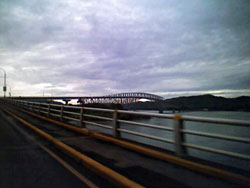 Unlike in the Visayas, the trip in Luzon was marvelous, to say the least. Although it was a bit overcast that morning, we still could see Mayon Volcano. The vast plains of Bicol is always a sight to behold. Too bad we forgot to buy frozen pinangat, which is one of my favorite Bicolano food.
Unlike in the Visayas, the trip in Luzon was marvelous, to say the least. Although it was a bit overcast that morning, we still could see Mayon Volcano. The vast plains of Bicol is always a sight to behold. Too bad we forgot to buy frozen pinangat, which is one of my favorite Bicolano food.
We made stopovers in Quezon, Lucena, and Batangas, enjoying the ice-cold drinks we brought and the chilled fresh pineapples we bought in Calauag, which the vendor graciously peeled and sliced for us.
Thank God for coolers and ice chests.
(A shorter version of this story is originally published in the June 19 issue of Newsbreak, one of the country�s top newsmagazines.)


